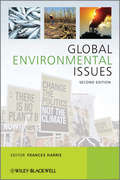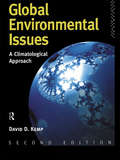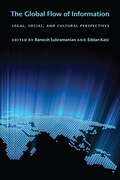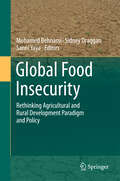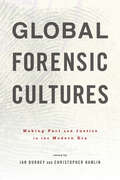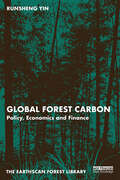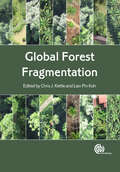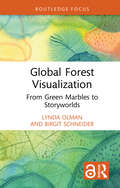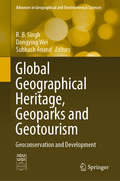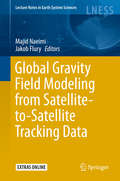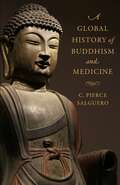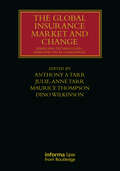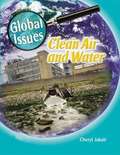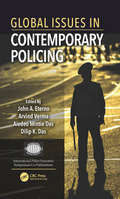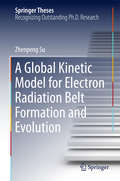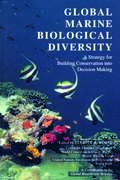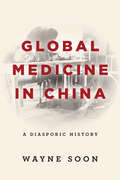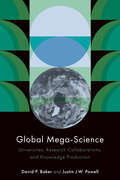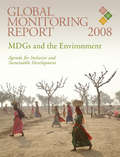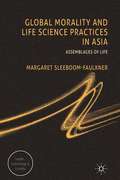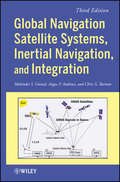- Table View
- List View
Global Environmental Issues
by Frances HarrisGlobal Environmental Issues, second edition builds on the popularity of the first edition, viewing global environmental problems as complex issues with a network of causes, influenced by a range of actors with differing priorities. The book recognises that science underpins much of what happens in society and therefore it is important to be able to interpret the environmental and social consequences of scientific developments. In addition to discussing the main biophysical causes, the book illustrates how socio-economic and political factors determine why and how people use land, resources and technology, and how this in turn affects natural resource management.This edition includes new chapters on the politics of science, International environmental regulation and treaties, environmental issues in a globalised world and natural resource management.Global Environmental Issues, second edition is essential reading for upper level undergraduates and Masters students within departments of Environmental Science and Geography.Includes case studies from around the world to provide a real life context for the issues tackled in each chapterConsiders both the results of human actions and natural environmental change in order to provide balanced, in-depth debateIncludes coverage of contemporary 'hot topics' such as biodiversity, globalization and sustainable developmentChapters authored by experts in the fieldIncludes new chapters on The politics of science, International environmental regulation and treaties , Environmental issues in a globalised world and Natural Resource ManagementExpanded sections include negotiating multilateral environmental agreements, GM crops, biofuels and marine and freshwater resources
Global Environmental Issues: A Climatological Approach
by David KempThis book provides a balanced account of the global environmental issues which threaten our society and which we neglect at our peril. Analysing both social and environmental components of the issues - global warming, ozone depletion, acid rain and drought - the book offers a valuable integrative approach and a detailed analysis of environmental issues in a clear, non-technical manner. Emphasising the climatological dimension common to all environmental issues, Global Environmental Issues recognises the multi-faceted nature of the issues, their common causes and the possibility of common solutions. Assessment of socio-economic, cultural amd political factors provides a balanced introduction to both the dangers and advantages of human interference with the environment. What have we done to deserve our current environmental crisis? Can we solve our current environmental problems, or is it too late?This new edition of a best selling text is completely updated and expands to include greater detail and new material such as a new section on atmospheric modelling. A glossary has been added together with a bibliography for further reading at the end of each chapter, allowing readers to develop their interest in specific areas. The interdisciplinary text will prove invaluable to students in geography, environmental studies and other courses in whcih the environmental approach is emphasised.
Global Ethics and Environment
by Nicholas LowAs global capitalism expands and reaches ever-further corners of the world, practical problems continue to escalate and repercussions become increasingly serious and irreversible. These practical problems carry with them equally important and ethical issues.Global Ethics and Environment explores these ethical issues from a range of perspectives and using a wide range of case studies. Chapters focus on: the impact of development in new industrial regions; the ethical relationship between human and non-human nature; the application of ethics in different cultural and institutional contexts; environmental injustice in the location of hazardous materials and processes; the ethics of the impact of a single event (Chernobyl) on the global community; the ethics of transitional institutions.This collection will both stimulate debate and provide an excellent resource for wide-ranging case study material and solid academic context.
The Global Flow of Information: Legal, Social, and Cultural Perspectives (Ex Machina: Law, Technology, and Society #5)
by Eddan Katz Ramesh SubramanianThe Internet has been integral to the globalization of a range of goods and production, from intellectual property and scientific research to political discourse and cultural symbols. Yet the ease with which it allows information to flow at a global level presents enormous regulatory challenges. Understanding if, when, and how the law should regulate online, international flows of information requires a firm grasp of past, present, and future patterns of information flow, and their political, economic, social, and cultural consequences.In The Global Flow of Information, specialists from law, economics, public policy, international studies, and other disciplines probe the issues that lie at the intersection of globalization, law, and technology, and pay particular attention to the wider contextual question of Internet regulation in a globalized world. While individual essays examine everything from the pharmaceutical industry to television to "information warfare" against suspected enemies of the state, all contributors address the fundamental question of whether or not the flow of information across national borders can be controlled, and what role the law should play in regulating global information flows.Ex Machina seriesContributors: Frederick M. Abbott, C. Edwin Baker, Jack M. Balkin, Dan L. Burk, Miguel Angel Centeno, Dorothy E. Denning, James Der Derian, Daniel W. Drezner, Jeremy M. Kaplan, Eddan Katz, Stanley N. Katz, Lawrence Liang, Eli Noam, John G. Palfrey, Jr., Victoria Reyes, and Ramesh Subramanian
Global Food Insecurity
by Sanni Yaya Mohamed Behnassi Sidney DragganHuman-kind and ecological systems are currently facing one of the toughest challenges: how to feed more billions of people in the future within the perspective of climate change, energy shortages, economic crises and growing competition for the use of renewable and non renewable resources. This challenge is even more crucial given that we have not yet come close to achieving the Millennium Development Goal of halving the number of people living in extreme poverty and hunger. Scientists and relevant stakeholders are now voicing a clear message: that multiple challenges the world is facing require innovative, multifaceted, science-based, technological, economic and political approaches in theoretical thinking, decision making and action. With this background central to survival and well-being, the purpose of this volume is to formulate and promote relevant theoretical analysis and policy recommendations. The major perspective of this publication is that paradigm and policy shifts at all levels are needed urgently. This is based on the evidence that agriculture in the 21st century will be undergoing significant demands, arising largely from the need to increase the global food enterprise, while adjusting and contributing to climate change adaptation and mitigation. Global Food Insecurity aims at providing structure to effect achievement of this critically needed roadmap.
Global Forensic Cultures: Making Fact and Justice in the Modern Era
by Ian Burney and Christopher HamlinEssays explore forensic science in global and historical context, opening a critical window onto contemporary debates about the universal validity of present-day genomic forensic practices.Contemporary forensic science has achieved unprecedented visibility as a compelling example of applied expertise. But the common public view—that we are living in an era of forensic deliverance, one exemplified by DNA typing—has masked the reality: that forensic science has always been unique, problematic, and contested. Global Forensic Cultures aims to rectify this problem by recognizing the universality of forensic questions and the variety of practices and institutions constructed to answer them.Groundbreaking essays written by leaders in the field address the complex and contentious histories of forensic techniques. Contributors also examine the co-evolution of these techniques with the professions creating and using them, with the systems of governance and jurisprudence in which they are used, and with the socioeconomic, political, racial, and gendered settings of that use. Exploring the profound effect of "location" (temporal and spatial) on the production and enactment of forms of forensic knowledge during the century before CSI became a household acronym, the book explores numerous related topics, including the notion of burden of proof, changing roles of experts and witnesses, the development and dissemination of forensic techniques and skills, the financial and practical constraints facing investigators, and cultures of forensics and of criminality within and against which forensic practitioners operate.Covering sites of modern and historic forensic innovation in the United States, Europe, and farther-flung imperial and global settings, these essays tell stories of blood, poison, corpses; tracking persons and attesting documents; truth-making, egregious racism, and sinister surveillance. Each chapter is a finely grained case study. Collectively, Global Forensic Cultures supplies a historical foundation for the critical appraisal of contemporary forensic institutions which has begun in the wake of DNA-based exonerations.Contributors: Bruno Bertherat, José Ramón Bertomeu Sánchez, Binyamin Blum, Ian Burney, Marcus B. Carrier, Simon A. Cole, Christopher Hamlin, Jeffrey Jentzen, Projit Bihari Mukharji, Quentin (Trais) Pearson, Mitra Sharafi, Gagan Preet Singh, Heather Wolffram
Global Forest Carbon: Policy, Economics and Finance (The Earthscan Forest Library)
by Runsheng YinThis book addresses the major policy, economic and financial issues encountered in global forest carbon.The global forest sector is expected to play a major role in achieving the Paris Agreement’s temperature targets. Therefore, there is an urgent need to explore practical and promising solutions to the challenges facing carbon accounting and policy assessment as the global community undertakes forest sector actions—including the widely known REDD+ initiative. This book demonstrates how vital it is that we identify appropriate perspectives and formulate approaches to address these challenges in an integrated and effective manner. In doing so, it addresses many of the major issues, including the differential potentials for carbon sequestration within various forest ecosystems as well as for storage within a variety of harvested wood products, the joint production of timber and carbon, and the measurement and impact of forest carbon offsets and credits, results-based payments, and other nationally determined contributions centered differences as well. The book examines regional and country-level case studies from across the world and draws on the author's decades of experience working on forest policy and with the forest sector. Overall, this book highlights the technical and policy issues regarding forest sector carbon emission and removal to build useful perspectives, frameworks, and methods for addressing these issues successfully in the future. It advances the knowledge frontiers of global forest carbon policy, economics and finance as well as the ability to assess the effectiveness, efficiency, and equity of forest climate solutions.This book is essential reading for professionals and policymakers working at the intersection of forest policy, carbon storage and climate change, as well as students and researchers in the fields of forestry, natural resource management, climate change and nature-based solutions.
Global Forest Fragmentation
by Alexandra-Maria Klein Aline Finger Andrew D. Barnes Bruce L. Bruce L. Campbell O. Campbell O. Christopher Christopher Claude Claude Edgar C. Edgar C. Jan C. Jan C. Joern Joern Jürgen Jürgen Katharine J.M. Katharine J.M. Keith Keith Kelvin S.H Kelvin S.H Kinari Kinari Laurène Laurène Jahi Jahi Panut Panut Raphael K. Didham Rhett D. Rhett D. Richard T. Richard T. Richard B. Richard B. Sarah A. Sarah A. Sarah H. Sarah H. Shonil Shonil Stacy M. Stacy M. Timm F. Timm F. Ute UteForest fragmentation will inevitably continue over the coming years, especially in developing economies. This book provides a cutting edge review of the multi-disciplinary sciences related to studies of global forest fragmentation. It specifically addresses cross-cutting themes from both an ecological and a social sciences perspective. The ultimate goal of Global Forest Fragmentation is to provide a detailed scientific base to support future forest landscape management and planning to meet global environmental and societal needs.
Global Forest Fragmentation
by Stacy M. Stacy M. Jürgen Jürgen Bruce L. Bruce L. Ute Ute Timm F. Timm F. Lian Pin Koh Katharine J.M. Katharine J.M. Raphael K. Didham Joern Joern Panut Panut Sarah H. Sarah H. Chris Kettle Jan C. Jan C. Claude Claude Richard T. Richard T. Sarah A. Sarah A. Laurène Laurène Edgar C. Edgar C. Campbell O. Campbell O. Andrew D. Barnes Shonil Shonil Aline Finger Keith Keith Alexandra-Maria Klein Kinari Kinari Jahi Jahi Richard B. Richard B. Kelvin S.H Kelvin S.H Christopher Christopher Rhett D. Rhett D.Forest fragmentation will inevitably continue over the coming years, especially in developing economies. This book provides a cutting edge review of the multi-disciplinary sciences related to studies of global forest fragmentation. It specifically addresses cross-cutting themes from both an ecological and a social sciences perspective. The ultimate goal of Global Forest Fragmentation is to provide a detailed scientific base to support future forest landscape management and planning to meet global environmental and societal needs.
Global Forest Governance and Climate Change: Interrogating Representation, Participation, And Decentralization (Palgrave Studies In Natural Resource Management Ser.)
by Emmanuel O. NuesiriThis edited collection assesses governance in forestry programmes and projects, including REDD+ governance. It examines political representation, participation and decentralisation in forest governance, providing insight as to how forest governance arrangements can be responsive to the socio-economic interests of local people and communities who live adjacent to and depend on forests.Global Forest Governance and Climate Change argues that inclusive complementary representation of local communities is required for strong participatory processes and democratic decentralisation of forest governance. Responsiveness to local people’s socio-economic interests in forestry initiatives require paying attention to not just the hosting of participatory meetings and activities, but also to the full cast of appointed, self-authorized, and elected representative agents that stand, speak, and act for local people. This book will be of interest to students and academics across the fields of climate change governance, forestry, development studies, and political economy. It will also be a useful resource for policy makers and practitioners responsible for forestry and climate change initiatives.
Global Forest Visualization: From Green Marbles to Storyworlds (Routledge Focus on Environment and Sustainability)
by Lynda Olman Birgit SchneiderThis book project examines global forest monitoring as a means to understand the promises and problems of global visualization for climate management.Specifically, the book focuses on Global Forest Watch, the most developed and widely available forest-monitoring platform, created in 1997 by the World Resource Institute. Forest maps are always political as they visualize power relations and form the grid within which forests become commodities. This dislocation of the idea of the forest from its literal roots in the ground has generated problems for forest visualization efforts designed to empower local communities. This book takes a critical humanistic approach to this problem, combining methods from the fields of rhetoric and media studies to suggest solutions to these problems for designers and users of platforms like the Global Forest Watch. To explain why global views of forests can be disempowering, the book relies on biopolitical and rhetorical theories of panopticism and how these views unfold a different violence on different regions of the Earth in relation to colonial history. Using this theoretical framework, the book explains the historical process by which forests came to be classified, quantified, and mapped on a global scale. Interviews with end-users of global forest visualization platforms reveal if and how these platforms support local action. Lastly, the book provides rhetorical solutions to articulate global and local views of forests without reducing one view to the other. These solutions involve looking to forests themselves for clues about how to generate more broadly effective and resilient visualizations.This book will be of great interest to students and scholars of forest studies, climate change, science communication, visualization studies, environmental communication, and environmental conservation.The Open Access version of this book, available at http://www.taylorfrancis.com, has been made available under a Creative Commons [Attribution-Non Commercial-No Derivatives (CC-BY-NC-ND)] 4.0 license.
Global Geographical Heritage, Geoparks and Geotourism: Geoconservation and Development (Advances in Geographical and Environmental Sciences)
by R. B. Singh Dongying Wei Subhash AnandThis book explores the geographical, geomorphological, ecological, touristic and socioeconomic aspects of natural heritage, argues for the dynamic conservation of that heritage and explains its key characteristics, promotion, conservation and management to achieve sustainable development goals. Emerging concepts such as geodiversity, geographical heritage sites, geomonuments, geoparks and geotourism are increasingly being used by conservationists. At present, the development of geoparks is a major global theme involving the application of geosciences to promote the inclusive growth of society and the protection and conservation of our unique geoheritage. Currently, there are 147 UNESCO global geoparks across 41 countries, in addition to a number of national-level geoparks. Pursuing a holistic approach towards such sites will sensitise the general public to the need for geoconservation of significant geosites and promote it through geotourism. It is a crucial issue, as various countries around the world are eager to develop their geoparks and are working for the conservation of geoheritage sites at the national level. This unique book gathers contributions from 15 countries in the form of case studies analysing the realities on of geographical heritage, geoparks and geotourism. The respective chapters address the role of geoparks as essential tools for education, recreation and nature conservation. Given its scope, the book offers a valuable guide for geoscientists, planners, policymakers, civil society and anyone concerned about the conservation of geoheritage sites and geoparks for a sustainable future Earth.
Global Gravity Field Modeling from Satellite-to-Satellite Tracking Data
by Majid Naeimi Jakob FluryThis book provides a sound theoretical basis for the the different gravity field recovery methods and the numerics of satellite-to-satellite tracking data. It represents lectures given at the 'Wilhelm and Else Heraeus Autumn School' in Bad Honnef, Germany, October 4-9, 2015. The emphasis of the school was on providing a sound theoretical basis for the different gravity field recovery methods and the numerics of data analysis. The approaches covered here are the variational equations (classical approach), the acceleration approach and the energy balance approach, all of which are used for global gravity field recovery on the basis of satellite observations. The theory of parameter estimation in satellite gravimetry and concepts for orbit determination are also included. The book guides readers through a broad range of topics in satellite gravimetry, supplemented by the necessary theoretical background and numerical examples. While it provides a comprehensive overview for those readers who are already familiar with satellite gravity data processing, it also offers an essential reference guide for graduate and undergraduate students interested in this field.
A Global History of Buddhism and Medicine
by C. Pierce SalgueroMedicine, health, and healing have been central to Buddhism since its origins. Long before the global popularity of mindfulness and meditation, Buddhism provided cultures around the world with conceptual tools to understand illness as well as a range of therapies and interventions for care of the sick. Today, Buddhist traditions, healers, and institutions continue to exert a tangible influence on medical care in societies both inside and outside Asia, including in the areas of mental health, biomedicine, and even in responses to the COVID-19 pandemic. However, the global history of the relationship between Buddhism and medicine remains largely untold.This book is a wide-ranging and accessible account of the interplay between Buddhism and medicine over the past two and a half millennia. C. Pierce Salguero traces the intertwining threads linking ideas, practices, and texts from many different times and places. He shows that Buddhism has played a crucial role in cross-cultural medical exchange globally and that Buddhist knowledge formed the nucleus for many types of traditional practices that still thrive today throughout Asia. Although Buddhist medicine has always been embedded in local contexts and differs markedly across cultures, Salguero identifies key patterns that have persisted throughout this long history. This book will be informative and invaluable for scholars, students, and practitioners of both Buddhism and complementary and alternative medicine.
The Global Insurance Market and Change: Emerging Technologies, Risks and Legal Challenges (Lloyd's Insurance Law Library)
by Anthony A Tarr, Julie-Anne Tarr, Maurice Thompson and Dino WilkinsonThis book focuses on the global landscape in which insurance is transacted, and where it is evolving, driven from within by transformative technologies and externally by the necessity to address risks like climate change and health crises, such as the COVID-19 pandemic. It discusses the dynamic challenges and opportunities that lie ahead for the industry in areas such as on-demand insurance, embedded insurance, parametric insurance, autonomous vehicles, the rise of fintech, the cyber risk landscape and through initiatives driven by distributed ledger technology or blockchain solutions. Moreover, it covers the major external challenges confronting the global insurance market, such as the growing insurance protection gap in relation to the affordability and insurability of natural catastrophes and climate change, and pandemics like COVID-19. This book examines innovations in insurance driven by the industry as well as externally imposed changes and dynamics impacting the industry. It describes these changes, the industry’s responses and the legal framework in which they occur. It canvasses additional regulatory and law reform initiatives that may be necessary to achieve an effective balance between the various competing interests. The book is the first to address these matters holistically with a particular focus upon insurance law, it will describe these changes and industry responses and the legal framework in which they occur. The Global Insurance Market will be directly relevant to legal professionals, insurers, insurtechs, fintechs, brokers, CEOs of insurance companies, risk managers, legal counsel, academics, researchers, the judiciary, and policy makers. It will also serve as a valuable resource for students of all levels.
Global Issues: Clean Air and Water
by Cheryl JakabHi there! This is Earth speaking. My environment is being threatened by some serious problems, and I need your help. My global challenge to you is to find ways to manage these issues and to build a sustainable future. The Global Issues series presents six major environmental topics. Each book takes one topic and examines it through five related issues. Each issue outlines the problem and offers solutions for a sustainable future. In Clean Air and Water, learn about the following issues: ISSUE 1 Polluting the air ISSUE 2 Polluting the water ISSUE 3 Fresh drinking water ISSUE 4 Acid rain ISSUE 5 Overuse of water Special features include: * two case studies for each issue * "What can you do?" advice for individuals
Global Issues in Contemporary Policing (International Police Executive Symposium Co-Publications)
by John A. Eterno Arvind Verma Aiedeo Mintie Das Dilip K. DasThis book addresses six areas of policing: performance management, professional and academic partnerships, preventing and fighting crime and terrorism, immigrant and multicultural populations, policing the police, and cyber-security. The book contains the most current and ground-breaking research across the world of policing with contributors from over 20 countries. It is also a suitable reference or textbook in a special topics course. It consists of edited versions of the best papers presented at the IPES annual meeting in Budapest.
A Global Kinetic Model for Electron Radiation Belt Formation and Evolution (Springer Theses)
by Zhenpeng SuThis thesis focuses on the construction and application of an electron radiation belt kinetic model including various adiabatic and non-adiabatic processes. The terrestrial radiation belt was discovered over 50 years ago and has received a resurgence of interest in recent years. The main drivers of radiation belt research are the fundamental science questions surrounding its complex and dramatic dynamics and particularly its potential hazards posed to space-borne systems. The establishment of physics-based radiation belt models will be able to identify the contributions of various mechanisms, forecast the future radiation belt evolution and then mitigate its adverse space weather effects. Dr. Su is now an Professor works in Department of Geophysics and Planetary Sciences, University of Science and Technology of China, Hefei, China.
Global Marine Biological Diversity: A Strategy For Building Conservation Into Decision Making
by Elliott A. NorseGlobal Marine Biological Diversity presents the most up-to-date information and view on the challenge of conserving the living sea and how that challenge can be met.
Global Medicine in China: A Diasporic History
by Wayne SoonIn 1938, one year into the Second Sino-Japanese War, the Chinese military found itself in dire medical straits. Soldiers were suffering from deadly illnesses, and were unable to receive blood transfusions for their wounds. The urgent need for medical assistance prompted an unprecedented flowering of scientific knowledge in China and Taiwan throughout the twentieth century. Wayne Soon draws on archives from three continents to argue that Overseas Chinese were key to this development, utilizing their global connections and diasporic links to procure much-needed money, supplies, and medical expertise. The remarkable expansion of care and education that they spurred saved more than four million lives and trained more than fifteen thousand medical personnel. Moreover, the introduction of military medicine shifted biomedicine out of elite, urban civilian institutions and laboratories and transformed it into an adaptive field-based practice for all. Universal care, practical medical education, and mobile medicine are all lasting legacies of this effort.
Global Mega-Science: Universities, Research Collaborations, and Knowledge Production
by David P. Baker Justin J.W. PowellNever has the world been as rich in scientific knowledge as it is today. But what are its main sources? In accessible and engaging fashion, Global Mega-Science examines the origins of this unprecedented growth of knowledge production over the past hundred and twenty years. David P. Baker and Justin J.W. Powell integrate sociological and historical approaches with unique scientometric data to argue that at the heart of this phenomenon is the unparalleled cultural success of universities and their connection to science: the university-science model. Considering why science is so deeply linked to (higher) educational development, the authors analyze the accumulation of capacity to produce research—and demonstrate how the university facilitates the emerging knowledge society. The age of global mega-science was built on the symbiotic relationship between higher education and science, especially the worldwide research collaborations among networked university-based scientists. These relationships are key for scholars and citizens to understand the past, future, and sustainability of science.
Global Monitoring Report 2008
by World Bank'Global Monitoring Report 2008', the fifth in an annual series, is essential reading for those who wish to follow the global development agenda and debate in 2008. The year marks the midpoint toward the 2015 deadline for achieving the Millennium Development Goals (MDGs). It is also an important year to work toward a consensus on how the world is going to respond to the challenge of climate change, building on the foundation laid at the Bali climate change conference in December 2007. The report spans this agenda. It provides a comprehensive assessment of progress toward the MDGs and related policies and actions. It addresses the challenge of climate change and environmental sustainability and assesses its implications for development. The report's assessment of MDGs at midpoint presents a mixed picture, one of both significant progress and formidable challenges. The first MDG, reducing extreme poverty by half, is likely to be met at the global level, thanks to a remarkable surge in global economic growth over the past decade. But, on current trends, the human development MDGs are unlikely to be met. Prospects are gravest for the goals of reducing child and maternal mortality, but shortfalls are also likely in the primary school completion. nutrition, and sanitation MDGs. The potential effects of climate change compound the challenge of achieving the development goals and sustaining progress. The report's messages are clear: urgent action is needed to help the world get back on track to achieve the MDGs; and urgent action is also needed to combat climate change that threatens the well-being of all countries, but particularly of poor countries and poor people. The goals of development and environmental sustainability are closely related, and the paths to those goals have important synergies.
Global Morality and Life Science Practices in Asia
by Margaret Sleeboom-FaulknerEmpirical studies of life science research and biotechnologies in Asia show how assemblages of life articulate bioethics governance with global moralities and reveal why the global harmonization of bioethical standards is contrived.
The Global Movement and Tracking of Chemical Manufacturing Equipment: A Workshop Summary
by Kathryn HughesDual-use applications for chemical manufacturing equipment have been recognized as a concern for many years, and export-control regulations worldwide are in place as a result. These regulations, in conjunction with the verification and inspection requirements of Article VI of the Chemical Weapons Convention, are designed to support non-proliferation of manufacturing equipment suitable for production of chemical warfare agents. In recent years, globalization has changed the distribution of chemical manufacturing facilities around the world. This has increased the burden on current inspection regimes, and increased the amount of manufacturing equipment available around the world. Movement of that equipment, both domestically and as part of international trade, has increased to accommodate these market shifts. To better understand the movement and tracking of chemical manufacturing equipment of dual-use concern, the Project on Advanced Systems and Concepts for Countering Weapons of Mass Destruction at the Naval Postgraduate School contracted with the Board on Chemical Sciences and Technology of the National Research Council to hold a workshop on the global movement and tracking of chemical manufacturing equipment. The workshop, held in May 2014, looked at key concerns regarding the availability and movement of equipment for chemical manufacturing, particularly used and decommissioned equipment that is of potential dual-use concern. The workshop examined today's industrial, security, and political contexts in which these materials are being produced, regulated, and transferred. The workshop also facilitated discussions about current practices, including consideration of their congruence with current technologies and security threats in the global chemical industrial system. "The Global Movement and Tracking of Chemical Manufacturing Equipment" summarizes the presentations and discussion of the event.
Global Navigation Satellite Systems, Inertial Navigation, and Integration
by Mohinder S. Grewal Angus P. Andrews Chris G. BartoneAn updated guide to GNSS, and INS, and solutions to real-world GNSS/INS problems with Kalman filtering Written by recognized authorities in the field, this third edition of a landmark work provides engineers, computer scientists, and others with a working familiarity of the theory and contemporary applications of Global Navigation Satellite Systems (GNSS), Inertial Navigational Systems, and Kalman filters. Throughout, the focus is on solving real-world problems, with an emphasis on the effective use of state-of-the-art integration techniques for those systems, especially the application of Kalman filtering. To that end, the authors explore the various subtleties, common failures, and inherent limitations of the theory as it applies to real-world situations, and provide numerous detailed application examples and practice problems, including GNSS-aided INS (tightly and loosely coupled), modeling of gyros and accelerometers, and SBAS and GBAS. Drawing upon their many years of experience with GNSS, INS, and the Kalman filter, the authors present numerous design and implementation techniques not found in other professional references. The Third Edition includes: Updates on the upgrades in existing GNSS and other systems currently under development Expanded coverage of basic principles of antenna design and practical antenna design solutions Expanded coverage of basic principles of receiver design and an update of the foundations for code and carrier acquisition and tracking within a GNSS receiver Expanded coverage of inertial navigation, its history, its technology, and the mathematical models and methods used in its implementation Derivations of dynamic models for the propagation of inertial navigation errors, including the effects of drifting sensor compensation parameters Greatly expanded coverage of GNSS/INS integration, including derivation of a unified GNSS/INS integration model, its MATLAB® implementations, and performance evaluation under simulated dynamic conditions The companion website includes updated background material; additional MATLAB scripts for simulating GNSS-only and integrated GNSS/INS navigation; satellite position determination; calculation of ionosphere delays; and dilution of precision.
